Learning Outcomes
By the end of this semester, all students should be able to:
- Identify the major factors which contribute to global climate systems, and predict in general how perturbations in these factors result in changes in climate.
- Understand how proxies of past conditions are used to reconstruct paleoclimates, and be able to interpret plots of these changing conditions over time.
- Recognize how climatic factors control the distribution and abundance of organisms (including crops and pathogens) and how changing global conditions result in redistribution and loss of important elements of the biosphere.
What is climate?
We'll revisit this issue in more detail later on. However, for the purposes for the start of the course, we'll use Mathez's short definition:
Climate is the average weather for a particular region over some time. That region may be as small as a county or as big as the whole
planet (global climate). Climate therefore includes weather but also variations in weather over time. Some researchers specify the amount
of time represented for the averaging (30 years is a commonly used numbers), but there is no hard and fast rule.
A folksy way of saying this is "Climate is what you expect, weather is what you get."
What CAUSES climate? We will investigate this in much greater detail later, but to start with there are three major factors:
- Insolation (incoming sunlight), the energy source for weather, and thus for climate
- Atmospheric composition (including particulate matter, clouds, and especially greenhouse gases), which may trap or reflect heat within the atmosphere depending on the composition
- Albedo (Latin for "whiteness"), the reflectivity of a surface (and thus whether the sunlight is just reflected back or absorbed to be reradiated as infrared radiation (aka "heat")
Climate change is, therefore, changes in the statistics of weather for a particular region over some time. Nothing in this definition requires climate change to be anthropogenic (human made), nor tied into changes in greenhouse gasses, nor be especially about warming per se. (As we will see, however, recent climate change is all three!)
Of concer to human affairs are three main consequences of climate change, which can perturb human affairs directly or via their effects on other parts of global systems. These three consequences of climate change are:
- Changes in local temperatures (minima, maxima, average)
- Changes in precipitation distribution (increases and decreases in frequency and intensity)
- Changes in sea level
As the course proceeds, we will see how each of these is affected by changes in the drivers of climate change, and how changes in these affect human society and technology.
Here is a graph of the distribution of summer temperatures relative to a 1951-1980 mean of Northern Hemisphere summer months (June-July-August):

(From the Goddard Institute of Space Studies, NASA)
Or, if you prefer, the same data in video format:
Here is another look: the Berkely Earth Surface Temperature (BEST) Project's reconstruction of changing temperatures over the course of the
instrumental record (that is, the period of time when there are thermometers and such to actualy take the temperature of the environment):
But (you might say), I've heard that the temperature has actually been cooling! That is a common myth spread by
climate change denialists (we'll investigate this community later this semester, and in detail in the third semester.)
Below is a figure that demonstrates one of the problem with their arguments:

And here is a video that explains this in even more detail:
How are climate and and climate change documented? After all, we are talking about averaged phenomena (rainfall, temperature, pressure, etc., etc., etc.) over the surface of the planet and over long periods of time. There are two main forms of observations we make concerning climates and climate systems:
- Instrumental: Thermometers, hygrometers, barometers, satellite remote sensing equipment, and anything else that takes direct readings of some factor of the climate system at some location at a particular time.
- Proxies: Migration patterns, plant flowering times, tree ring widths, isotope ratios in fossils or ice bubbles, borehole temperatures, the presence or absence of certain species, density of stomata on leaves, and anything else that scales proportionately in some manner to a climate parameter. Since the instrumental record has only been in operation for a few hundred years in the Europe--and much shorter time periods for the rest of the planet--our knowledge of past climates (paleoclimates) is derived mostly from proxies. However, depending on the proxy system used, we might be able to estimate past climate factors hundreds, thousands, millions, or even billions of years ago.
There is more to understanding climates than our current observations and past estimatations. If we want to forecast future events (that is, make predictions), we can rely on two major steps:
- Theory: mathematical models representing the interactions and forcings of different components of the climate system over time, based on experimental observations and theoretical interrelationships of these factors
- Computer Models: taking the theories of climate systems, modelling them as gigantic multifactorial spreadsheets, and running these models for some period of computational time to generate maps or other outputs representing changes in climate system over time.
We will be exploring some of these aspects over the next two semesters.
Deep Time
The science of Geology has provided (among other things) two very important concepts to humanity: unformitarianism and deep
time. Uniformitarianism is the recognition that natural laws and processes of the past are the same as those today (distinct
from the alternative: catastrophism, or the idea that natural laws and processes of the past are entirely different than those at present.)
Because of uniformitarianism, we can use observations of the modern environment to make predictions and estimations of conditions
of the past.
Deep time (a phrase coined by naturalist writer John McPhee) is the concept that the history of the Earth extends not merely the few centuries and millenia of human history, but rather back into the range of tens of thousands, hundreds of millions, and even billions of years. Geologists can reconstruct both the sequence of events in time (relative time) and the dates of ancient events (numerical time). The details of how geologists recover all this information are somewhat beyond the scope of this course, but you can read more about it here and here or here and here. In brief, though, geologists use a combination of factors to reconstruct both relative and numerical time, including but not limited to:
- Physical position of strata, deposited on on top of the other
- Deformation of previously existing strata by later events (faults, folds, erosion, etc.)
- Sequence of appearance and disappearance of fossil species
- Annual or other cyclical deposits of material (sediment, ice, etc.)
- Decay of various isotopes of naturally-occurring radioactive materials
- Change in the ratio or abundance of stable isotopes over time
- Changes in the Earth's magnetic field recorded in different types of rock
(NOTE: the proper grammar for geologic time is as follows:
- Dates before present is written in annum or "a"; durations are written in years or "yr"
- Prefixes in geologic time conform to the capitalization rules of metric prefixes more generally, so the lowercase "k" is 103 (kilo-, thousands), capital "M" is 106 (mega-, millions), and capital "G" is 109 (giga-, billions)
- Thus, 18 ka would be 18,000 years before present; 66 Ma would be 66,000,000 years ago; and 4.56 Ga would be 4,560,000,000 years ago.
- And 18 kyr would be any 18,000 year period in Earth history, rather than specifically the last 18,000 years. For example, the Mesozoic Era (which began at 252.2 Ma and ended 66.0 Ma) had a duration of 186.2 Myr.
Geologic Time Scale
Rather than constantly refer to particular numerical dates, however, geologists more often refer to large chunks of Earth's history
using the geologic time scale. The product mostly of relative dating (for more details than you need for the course, see here),
the geologic time scale breaks up deep time into large chunks of (unequal) length, whose transitions often represent major changes
in the physical and/or biological conditions of the Earth. The largest chunks of Earth's history (eons) typically contain subunits (eras)
which contain even smaller and smaller and smaller units (periods, epochs, ages). These chunks of history are typically given Latinate
names that often reflect some aspect of the Earth at that time (Archean = Old; Mesozoic = Middle Animal Life; etc.).
Here is an overview of the time scale as a whole:
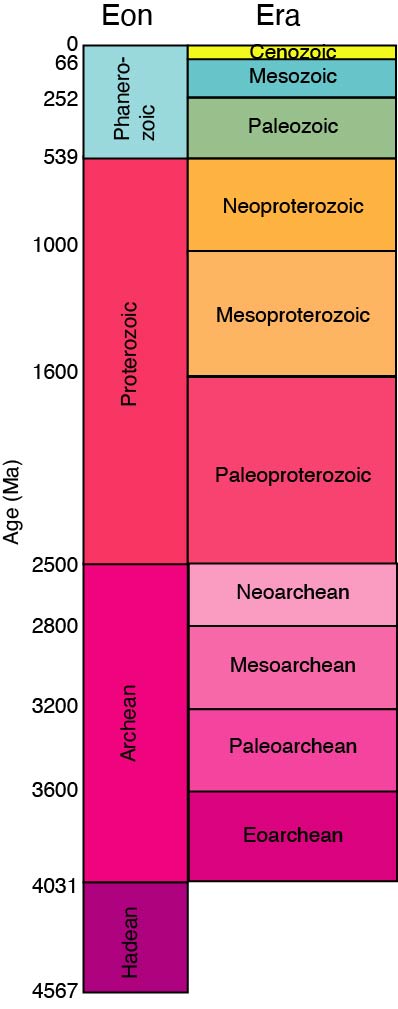
and here is a closeup of the last 542 million years (the Phanerozoic, or Age of Visible Animal Life, in which animals visible to the
naked eye and capable of producing preservable hard parts were common):
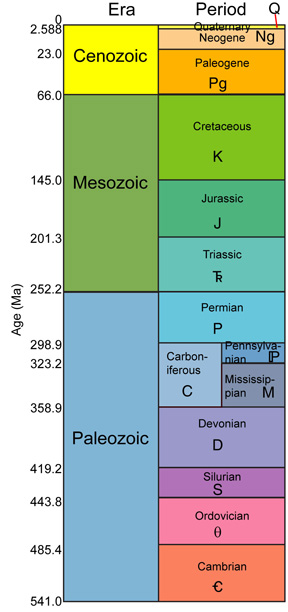
and even more close up, here is the Cenozoic Era (the last 1.4% of the history of the Earth, all time since the end of the Age of
Dinosaurs):
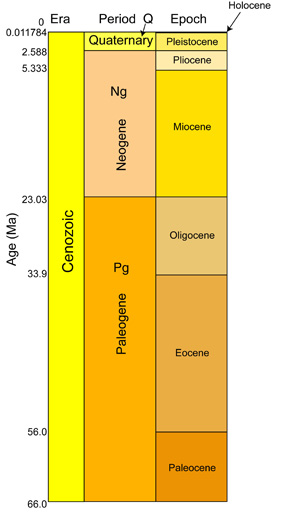
Or, if you prefer a video representation of Earth's history, watch the following:
To put some of the important events in Earth's history into context:
- The Earth formed 4.56 Ga (4,560,000,000 years ago)
- The oldest preserved rocks formed 4.03 Ga (4,030,000,000 years ago)
- The oldest traces of living things are found about 3.8 Ga (3,800,000,000 years ago)
- The atmosphere transformed from one composed mostly of carbon dioxide, ammonia, methane, and the like to the modern nitrogen-oxygen atmosphere between 2.7 and 2.4 Ga (2,700,000,000 and 2,400,000,000 years ago)
- The oldest definite eukaryotes (organisms with nucleated cells, mitochondria, etc.) are present by 1.78 Ga (1,780,000,000 years ago)
- The oldest definite animals (in the form of distinctive embryo fossils) are present by 600 Ma (600,000,000 years ago, or when nearly 87% of Earth's current history was already over)
- The oldest vertebrates are present by about 500 Ma (500,000,000 years ago)
- The oldest definite land plants are present by about 450 Ma (450,000,000 years ago), followed by arthropods and finally around 400 Ma (400,000,000 years ago) by vertebrates (at least for short trips)
- The oldest mammal-grade animals are present around 220 Ma (220,000,000 years ago), and the last common ancestor of all modern mammals by 170 Ma (170,000,000 years ago). (In between, the Atlantic Ocean was born around 200 Ma)
- The Age of Dinosaurs came to an end around 66 Ma (66,000,000 years ago), and the oldest primates date from nearly just around that time
- Grasslands developed in South America around 30 Ma (30,000,000 years ago) and spread into the other continents by 20 Ma (20,000,000 years ago)
- The divergence between the lineage containing humans and that containing our nearest closest relatives (chimps and bonobos) by 6 Ma (6,000,000 years ago, or after 99.9% of Earth's current history was already over)
- A modern cycle of Ice Ages begins 2.588 Ma (2,588,000 years ago), at the beginning of the Quaternary Period
- Our own species (Homo sapiens) first appeared around 250 ka (250,000 years ago)
- Humans began farming (first in the Fertile Crescent, and later spreading elsewhere) around 10 ka (10,000 years ago)
- The oldest known writing is about 6 ka (6000 years ago)
Or, another way to think about this: written human history is only about 0.00013% (1/760000) as long as the history of the planet.
The Neolithic (Agricultural) and Industrial Revolutions
On this scale it is hard to imagine that humans would have much effect on the planetary situation. However, the evidence is strong (we'll
get to the specifics later) that the combination of agriculture (the Neolithic Revolution) and technology (and in particular
the Industrial Revolution) allowed us to be a force to be reckoned with. (Actually, even pre-agricultural humans are implicated
in extinctions of many large-bodied animals around the world at the end of the last glacial cycle!)
Agriculture spread out from the Fertile Crescent to other parts of the Old World, and was independently developed in several other regions. Agriculture has two major consequences for Earth climate systems:
- It allows for humans to capture a far greater proportion of the productivity (nutrients generated per unit area per unit time) of the land than foraging (hunting and gathering), and thus far more humans can live in a region if they farm than if the do not
- The act of farming transforms the land from whatever particular biological community it once was into... well, farmland
With more and more parts of the Earth converted into regions to fuel more and more humans, the population of our species has
greatly increased:

(note that timescale is not linear, but population size is. World population should reach 7 billion in 2012 C.E.)
Our direct use of wild foods has greatly decreased, at least as regards to terrestrial animals (except for game, which is limited generally to the wilderness of the developing world and sports hunters in the developed world) and plants and fungi. Fishing, however, still has a large wild-based component.
Most of our food now comes from farming. As such, it uses a substantial fraction of the planet's surface. Large scale farming to support the cities of the world necessarily requires industrial farming equipment and chemical fertilizers (in order to allow a small fraction of the population to feed the rest).
Farming allowed for a tremendous increase in population, and allows us to capture progressively more and more of the planetary biomass to feed our species. Additionally, much of energy consumption has to do with growing and transporting food stuffs.
One of the most important nutrients that farming exhausts from the soil is nitrogen. While in older societies natural sources of nitrogen were used (guano from bats and birds; sal ammoniac; etc.), the Haber-Bosch process (developed in 1908) allows us to artificially generate ammonia. Via the Haber-Bosch process, humans generate about 100 Tg of nitrogen per year for agriculatural use, increasing yields such that where one acre used to support 1.9 people it now supports 4.3.
Supported by the products of farming, agricultural societies could afford to have specialists in metallurgy, pottery, and eventually more advanced forms of engineering. By the late 1700s and early 1800s C.E. Scottish engineers were uniting steam engines fueld by coal with steel-framed machines, leading to the Industrial Revolution. With coal-buring steam power (eventually assisted by petroleum- and methane-fueled internal combustion engines) it became far easier to farm; to transport huge amounts of material; to dig up and build on tracts of land; etc.)
As we saw last semester, however, such large-scale operations of fuel burning releases copious amounts of greenhouse gasses (about 7.9 Gt C
in 2009) into the atmosphere, among many other changes. The scale at which humans now release greenhouse gasses, fix nitrogen, produce
erosion, consume nutrients, and so forth is on a scale with planetary geological forces:
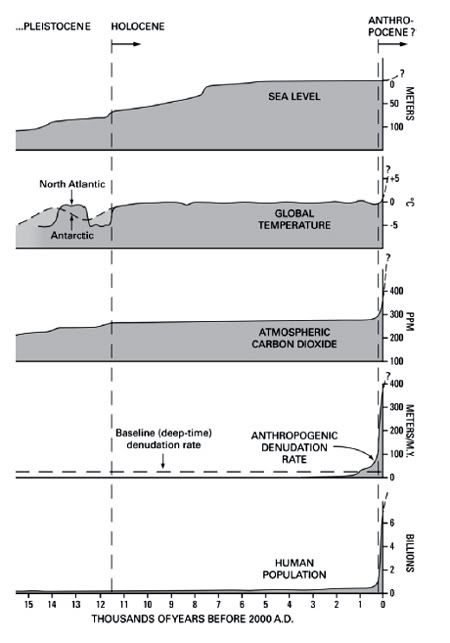
Some researchers have suggested that we have now entered the Anthropocene Epoch: a new phase of geologic time in which humans
represent a geologic force. I personally disagree with using this term as a geologic time period: we have a perfectly good term (Holocene Epoch)
for the last 11.7 ka, and when we get into shorter term time units we actually have good calendar systems and such! Additionally,
as we will see later on, the current situation is not sustainable at anything like geological time scales, and so the "Anthropocene"
repesents an event (like the Paleocene-Eocene Thermal Maximum or the Permo-Triassic Extinction) rather than a period. Furthermore,
it isn't entirely certain if the Anthropocene should be started with the Industrial Revolution (as typically used) or if (as William
Ruddiman of the University of Virginia argues) methane and carbon dioxide produced by early agriculturalists had a slow but steady
contribution, and thus it began with the Neolithic Revolution:
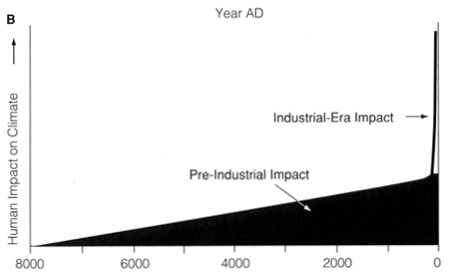
We aren't going to quibble over this here. Regardless of when and to what degree it began, we do live in a world in which human activity is one of the primary drivers of climate and change. We are definitely in the Anthropocene; it is now our job to understand what that means.

